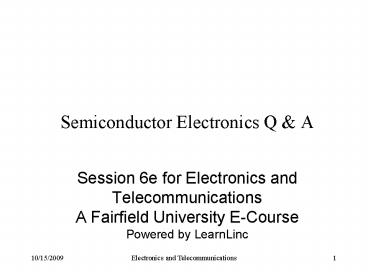Semiconductor Electronics Q PowerPoint PPT Presentation
1 / 14
Title: Semiconductor Electronics Q
1
Semiconductor Electronics Q A
- Session 6e for Electronics and Telecommunications
A Fairfield University E-CoursePowered by
LearnLinc
2
Module Semiconductor Electronics(in two parts)
- Text Electronics, Harry Kybett, Wiley, 1986,
ISBN 0-471-00916-4 - References
- Electronics Tutorial (Thanks to Alex Pounds)
- Electronics Tutorial (Thanks to Mark Sokos)
- 5 - Semiconductors, Diodes and Bipolar
Transistors - 5 on-line sessions plus one lab
- 6 - FETs, SCRs, Other Devices and Amplifiers
- 5 on-line sessions plus one lab
- Mastery Test part 3 follows this Module
3
Section 6 FETs, SCRs, Other Devices and
Operational Amplifiers
- 0BJECTIVES This section reviews additional
important semiconductor devices and their
applications. The Operational Amplifier is also
studied.
4
Section 6 Schedule
5
Topics
- Semiconductors and Doping
- Diodes and Applications
- Bipolar Transistors
- Transistor Amplifiers
- Field Effect Transistors
- Transistors as a switch
- Other Devices
- Class A, B, and C amplifiers
- Operational Amplifiers (next time)
6
Diodes
- Diodes are electronic one-way valves
- Current can flow from anode to cathode
- Current is blocked in the reverse direction
- Forward voltage drop
- Silicon Vf 0.7 volts
- Germanium Vf 0.3 volts
- Schottky Vf 0.1 volts
- GaAs Vf 2 volts
- Peak Inverse Voltage (PIV, PRV, Zener)
- These are non-linear devices ( no superposition )
7
Diode Analysis Review
- First determine if the diode is
- Forward biased conducting with a small voltage
drop - Reverse biased an open switch
- In reverse breakdown (PIV) conducting with a
large voltage drop (The Zener voltage) - Replace the diode with a simple equivalent and
then analyze the circuit (Ohm and Kirchoff) - Check power dissipation in each component to
avoid overheating
8
Transistor Review
- Transistors have three leads base, emitter and
collector - Testing via ohm meter
- Two diodes back to back test each separately for
impedance ratio - Check collector to emitter for high impedance
(leakage) - Beta (?) Current gain ? IC/IB , as long as no
saturation (VCE gt 0.2v) - Transistor action
- Carriers injected into depletion region (very
thin base region) - NPN and PNP currents and voltages reversed
- Analyze Base current (IB) flow as a diode
- Collector current IC IB ?
- Collector voltage VC Vbatt - IC RC
9
Transistor Review (2)
- Amplifier Configurations
- Common Emitter (voltage gain)
- Common Collector (buffer, low output impedance)
- Common Base (only used in some high frequency
applications) - Non-Linear Operation
- Saturation Transistor is fully on (Vce 0.2, low
?) - Cutoff Transistor is off (Vbelt 0.5, Ic 0)
10
FET Summary
- A voltage-controlled resistor
- Channel material
- N-channel FET
- P-channel FET
- FET types
- Junction FET (JFET)
- Metal Oxide Gate FET (MOSFET)
- Complementary Symmetry MOSFET (CMOS)
- Simple high input impedance amplifiers
- Very effective as switches
11
Transistor Switch Summary
- Can be either Bipolar or FET
- They operate fully in saturation or cutoff
- Bipolar Current controlled switch
- NPN 0.7 volt base-emitter ON
- PNP -0.7 volt base-emitter ON
- FET Voltage controlled switch
- N-Ch JFET -5 volt gate-source OFF, 0 volt ON
- P-Ch JFET 5 volt gate-source OFF, 0 volt ON
- MOSFET 0 volt gate-source Off, 5 volt
gate-source ONPositive for N-Ch, Negative for
P-Ch
12
Other Devices
- SCR Half wave current controlled triggered
switch - 4 layers, normally off, triggered on
- Reverse bias turns it off
- Triac Full wave triggered switch
- Effectively two SCRs in parallel (reverse
polarity) - Diac (and neon bulb) 2-terminal Avalanche device
- Normally high impedance,
- Low impedance triggered by threshold voltage
- Reverse bias turns it off
- UJT 3-terminal voltage controlled
avalanche/recovery
13
Amplifier Summary
14
Section 6 Schedule

